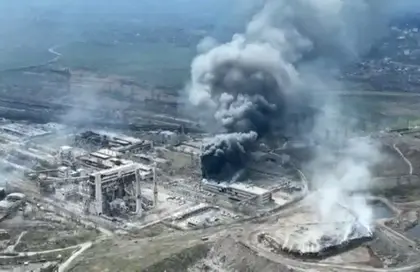The Kyiv Post sat down with Alexey Rashchupkin, managing partner at Kyiv-based investment bank Altius Capital, to do a quick tally of the economic losses that Ukraine has incurred since Russia unleashed an all-out invasion on its one-time major trading partner earlier this year.
For the average Ukrainian, the effects of higher petrol prices, stagnant wages, a weakened Hryvnia and low rents on properties are alarmingly clear. But, when looked at sector-by-sector, the country’s economic picture becomes more sobering, and the challenges ahead more long term.
JOIN US ON TELEGRAM
Follow our coverage of the war on the @Kyivpost_official.
To begin with, Ukraine, once a serious global steel maker, has lost half of its steel production: The Azov Steel Plant and the Ilyich Iron and Steel Works – both in the now devastated southern city of Mariupol.
The two metallurgical facilities were owned by Donetsk-based oligarch Rinat Akhmetov and together accounted for half of Ukraine’s steel production. The other half – Viktor Pinchuk’s Interpipe and ArcelorMittal Kryvyi Rih (part of multinational ArcelorMittal) – are in Ukrainian-controlled Dnipropetrovsk Region.
The loss to Ukraine is not only a matter of the plants and surrounding infrastructure themselves, but of jobs and social services, taxes on sales and export, Rashchupkin said.
The losses to Ukraine’s agro sector have gotten more media attention, which abound with stories of Russian forces capturing Ukrainian land, stealing the country’s grain and blockading its ports.

Ukrainians Repel Russians in East, Destroy $77M in Weaponry as Glide Bombs Target Kharkiv Region
Sadly, over the last five or so years, even with war simmering in eastern Ukraine, the country had managed to increase yields by 50%, harvesting more than 100 million tons of grain and oil seeds in 2021. But this year, the expectation is for a 30% decrease year on year, despite the fact that Ukrainian farmers were able to harvest winter crops.
The problem, however, is more about getting the grain out of the country than getting it out of the ground, the banker emphasized.
“The blockade is not only starving Ukraine but Africa and the Middle East,” underlines Rashchupkin. And Ukraine’s Black Sea ports are about more than just grain, with around 90% of all exports leaving the country by sea, mostly through Odesa and Mykolaiv – still held by Ukraine, then Mariupol and a little from Kherson, now under Russian occupation.
Blockaded Black Sea ports have had less of an adverse effect on Ukraine’s Fast Moving Consumer Goods, with much production still intact at home. Instead, the challenge to this sector is the loss of people, both workers and consumers fleeing their homes and the country. Around 7m Ukrainians have fled to Europe, with some returning home recently: others have migrated from eastern Ukraine, where much of the country’s production is, to western Ukraine, where there is less death and destruction.
And of those who have fled the country, many may never return – particularly those of prime working age, both skilled and unskilled, Rashchupkin said.
In London, for example, the service industry used to be staffed by Turks in the 2000s, then Poles and people from the Baltics, the banker explained. Now low-skilled Ukrainians will take their place.
“It’s about supply and demand.” Poland has taken in the most Ukrainian refugees, many of whom are replacing the low skilled labor Poland lost to the EU. In 2018-2019, the Polish government was ready to give visas to one million Ukrainians to fill the labor shortage there. Now, they are getting three times this amount in refugees.
“That’s why you see low-cost airlines flying to small towns in Europe, not just because the airport fees and traffic is less, but because Ukrainians have been flying back and forth to their jobs there.”
Other industries such as food production have also been hit more by loss of labor than loss of production facilities. Some of the country’s food processing plants, for example, were destroyed, but the main problem is that Ukraine has lost a quarter of its labor force – people who make as well as consume Ukrainian processed food.
Ukraine’s pharmacy sector has seen a 40% drop in production, but only 25-30% of revenues due to the devaluation of the Hryvnia.
On the bright side, the IT sector has remained amazingly steady during the war, seeing little to no drop in revenues. Many of the women who worked in IT have gone abroad, where they continue to do their jobs, but the men have been forced to stay behind. And these men are not only staying to fight but to work.
“The government has a plan whereby Ukrainians are divided into two groups – those fighting and those working,” Rashchupkin underlines.
Amid all its losses, Ukraine is receiving aid from the West, mostly from the U.S. and mainly in the form of weapons. And perhaps counter-intuitively, Lend-Lease is a win-win situation.
For example, by sending Ukraine weapons, the U.S. is not only pushing back on Russian aggression, but testing those weapons in a real theater of war. Some of this war materiel is nearing the end of its shelf life anyway and will have to be replaced with new orders from U.S. defense plants, thus stimulating new jobs, taxes, etc. in the U.S.
The U.S. also stands to gains by boosting sales of liquefied gas to Europe, as the continent rejects Russian imports.
But perhaps most promising of all in Ukraine and abroad, will be Western investment into the rebuilding of Ukraine after the war has been won.
You can also highlight the text and press Ctrl + Enter








